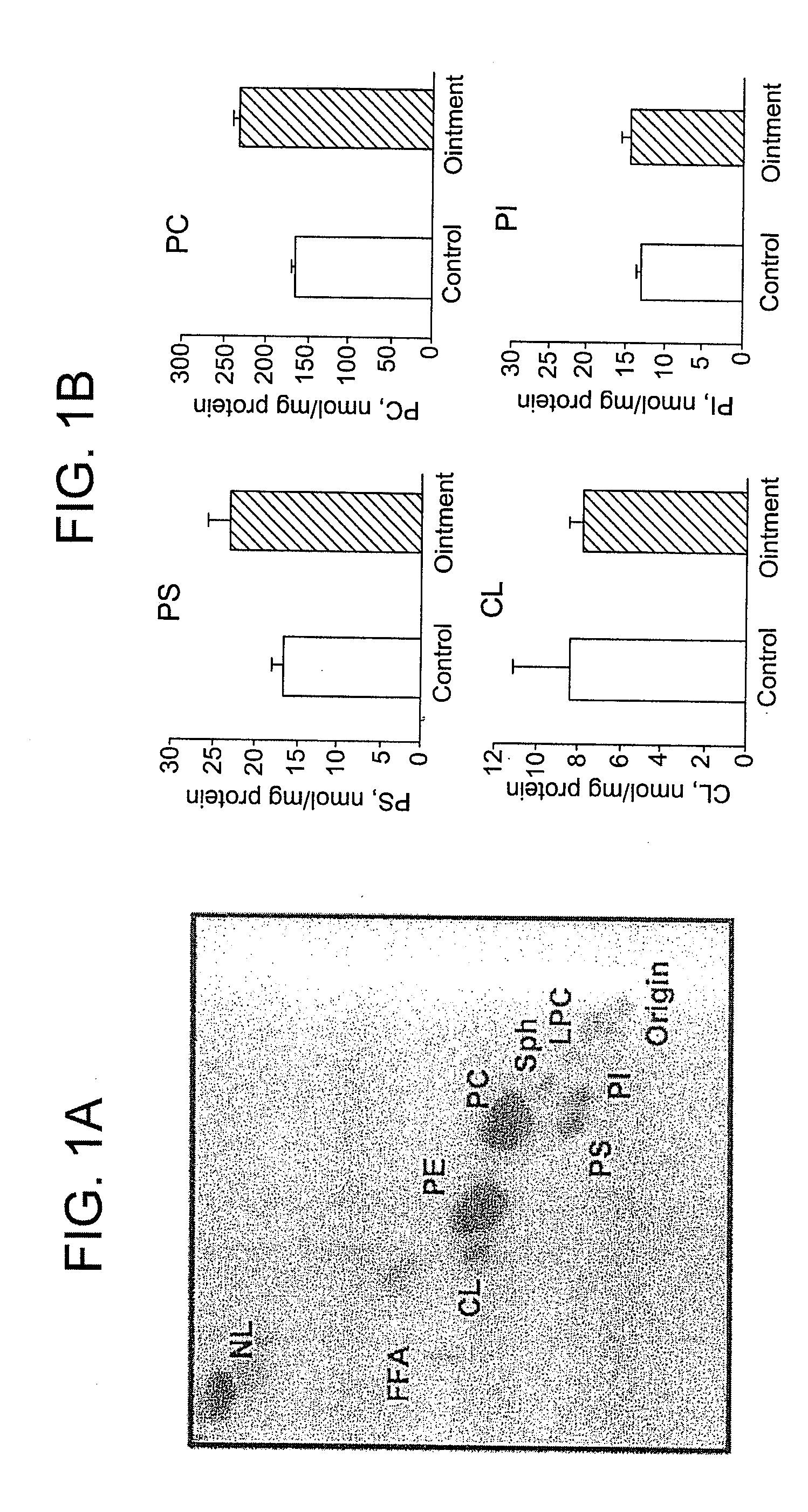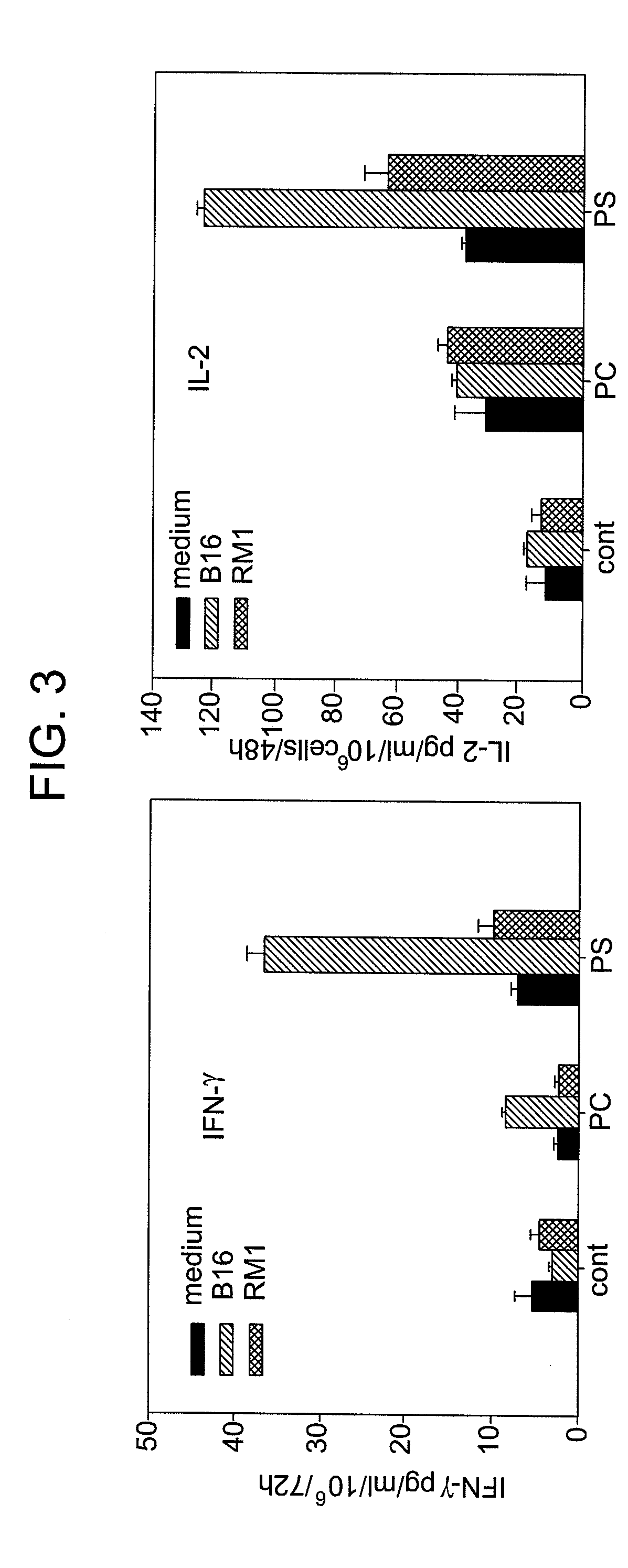Ointment for cancer treatment
a cancer and anointment technology, applied in the field of anointment for cancer treatment, can solve the problems of difficult to resolve contradictory findings, difficult clinical use of targeting agents such as antibodies, and inability to inhibit tumor growth, and achieve the effect of inhibiting tumor growth
- Summary
- Abstract
- Description
- Claims
- Application Information
AI Technical Summary
Benefits of technology
Problems solved by technology
Method used
Image
Examples
example 1
[0032]This example demonstrates the formulation of an ointment containing PS.
[0033]A basic ointment formulation, which consisted of the mixture of a fatty (oleic, C18:1) acid and PC or PC+PS. Oleic acid was utilized as a “solvent” for the phospholipids resulting in the molar ratio of oleic acid:DOPS:DOPC=33:1:7. This is equal to the weight ratio=1.6 g:150 mg:1 g.
[0034]DOPS and DOPC were obtained from a commercial source (Avanti Polar Lipids, Alabaster, Ala.). The formulation was prepared by dissolving the DOPS and DOPC in oleic acid.
[0035]The basic formulation of the inventive ointment caused significant inhibition of melanoma growth in vivo in B16 mouse tumor models in 3 independent experiments. In vitro studies suggest that the ointment may work through the induction of phagocytosis of PS-expressing LIVE tumor cells by dendritic cells and thus, initiation of antitumor immune responses in mice.
example 2
[0036]This example demonstrates that that topical skin application of the PS-containing ointment is associated with the phospholipid penetration through the skin and incorporation in surrounding cells.
[0037]The ointment was prepared in accordance with example 1 except that 20%3 of PS was substituted with fluorescently labeled PS. 1-palmitoyl-2-(6-(7-nitrobenz-2-oxa-1,3-diazol-4-yl)-aminocaproyl) (NBD)-labeled PS (NBD-PS) (Avanti Polar Lipids) was used as the fluorescent probe. B 16 tumor was growing in mice s.c. for 7 days followed by the application of the NBD-PS-ointment twice daily for 3 consecutive days.
[0038]After tumor mass incision and triple-enzyme digestion (collagenase, DNase, and hualuronidase), tumor cells were washed and cytospun. For labeling nuclear DNA, cells were preincubated with 1 μg / ml Hoechst (Molecular Probes) at 30° C. for 30 min. Blue and green fluorescent staining was analyzed by confocal microscopy. Green NBD-PS was detected on the surface and inside of man...
example 3
[0039]This example demonstrates that that topical skin application of the PS-containing ointment is associated with the phospholipid penetration through the skin and incorporation in surrounding cells.
[0040]The conclusion drawn from Example 2 was confirmed by a direct measurement of phospholipid levels in tumor cells isolated from PS-ointment-treated B16-bearing mice. Topical application of the PS-ointment over the growing tumor was initiated 7 days after s.c. inoculation of B16 cells and 3 days later mice were sacrificed and tumor were harvested. Control group included non-treated animals (3 mice / group). Tumor cells were isolated by a triple enzyme digestion and total lipids were extracted from cells using the Folch procedure [Folch, J Biol Chem 1957; 226:497-509]. The phospholipid classes in the extracts were separated by 2-dimensional HPTLC on silica G plates (5×5 cm, Whatman) as previously described [Tyurina, Antioxid Redox Signal 2004; 6:209-225]. Briefly, the plates were first...
PUM
| Property | Measurement | Unit |
|---|---|---|
| wt % | aaaaa | aaaaa |
| length | aaaaa | aaaaa |
| molecular weight | aaaaa | aaaaa |
Abstract
Description
Claims
Application Information
 Login to View More
Login to View More - R&D
- Intellectual Property
- Life Sciences
- Materials
- Tech Scout
- Unparalleled Data Quality
- Higher Quality Content
- 60% Fewer Hallucinations
Browse by: Latest US Patents, China's latest patents, Technical Efficacy Thesaurus, Application Domain, Technology Topic, Popular Technical Reports.
© 2025 PatSnap. All rights reserved.Legal|Privacy policy|Modern Slavery Act Transparency Statement|Sitemap|About US| Contact US: help@patsnap.com



